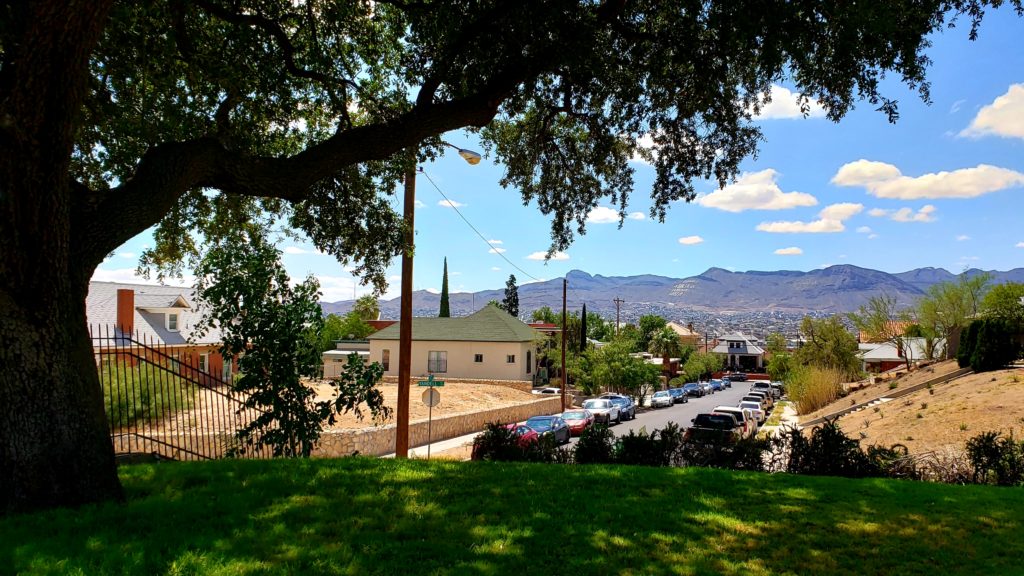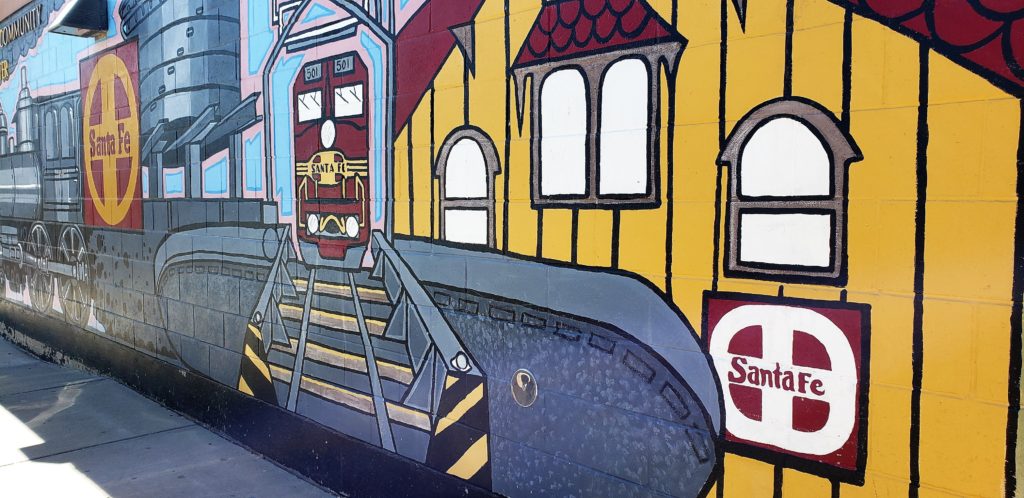By Denise Herrera, PhD, Senior Capacity Building Officer, St. David’s Foundation and PLACES 2019 Fellow
Going PLACES is an occasional blog series featuring the voices and experiences of TFN’s PLACES Fellows. For more information on the fellowship, and to read past blog posts from our fellows, visit here.

I grew up three and a half hours north of El Paso, so I was excited to visit a neighboring community I haven’t experienced since childhood. When I think of El Paso, I think of familia, resilience, community, traditions, culture, and food OMG — ALL THE DELICIOUS FOODS! I think about the growing relationships I’ve developed with Paso del Norte Health Foundation, which was kind enough to host a portion of our site visit. I’m intrigued that they serve about 2.4 million people across two countries (the U.S. and Mexico) and three states (Texas, New Mexico, and the Mexican state of Chihuahua).
The first question our TFN PLACES coach, Bina Patel, asked upon our arrival was, “What’s in your backpack? What are you carrying and what are you feeling?” I wrote in my journal feelings of immense pride, gratitude, and hope – particularly hopeful that community resilience and strong culture would prevail even in the darkest of political times. After all, family ties are much stronger than political ties, que no? It has been said that El Paso is the new Ellis Island of the Southwest, where people mobilize and move in every direction to pursue a better life. My PLACES cohort and I also (literally) had in our own “backpacks” hundreds of pairs of shoelaces, backpacks, and other supplies for immigrant families and asylum seekers. As families reach the U.S.-Mexico border, shoelaces are the first item confiscated, so individuals cannot run or cause self harm when in a detention or asylum center.

I also arrived believing that human beings created inequitable systems and institutions that don’t often allow immigrant families or communities of color to thrive. And I left trusting that if human beings have the capacity to create such unjust and broken systems, we can also dismantle them if we work together rather than in silos. As the honorable Bryan Stevenson would suggest, “We have a system of justice [in the U.S.] that treats you much better if you’re rich and guilty than if you’re poor and innocent. Wealth, not culpability, shapes outcomes. We all have a responsibility to create a just society.”
I have the honor of working toward social justice and health equity every single day. Being in the philanthropic sector is one of my life’s greatest privileges. There’s less red tape and bureaucracy in philanthropy compared to the federal government, academic institutions, and other sectors. If I’ve ever done significant soul-searching and questioned my life’s purpose, it’s happening right now. Congratulations for being part of my journey and free-flowing reflections.
Day 1. We had the pleasure of visiting the El Paso County Historical Society , developed in 1954 with support from the Women’s Department of the Chamber of Commerce. “El Paso is a crossroads, where millions of people have moved around, in and out, in all directions,” according to a professor from the University of Texas-El Paso. With the copper industry booming, the El Paso and Southwestern Railroad (formerly known as the South Eastern Railroad) was developed in 1888 and operated in Arizona, New Mexico and Texas, with extensions into Mexico. With the railroad came new jobs, a more diverse military, and a strong sense of community. People have traditionally felt safe and welcome in El Paso and don’t want to leave. From 2016 to 2018, El Paso was ranked among the top four safest U.S. cities per capita and for its size; from 2009 to 2018, El Paso averaged 16 murders a year. As one of our hosts eloquently stated, “There’s more crime in the White House than in El Paso.” Word.

I left the Historical Society with a better appreciation for how tough decisions are made regarding documenting important stories, such as the many lives lost due to the senseless act of domestic terrorism on Aug. 3, 2019. Without glorifying the event, it’s the Historical Society’s job to preserve and archive stories — such as vigils and memorials — so current and future generations learn from this horror so it never happens again.
The Historical Society also preserves stories of triumph, such as the tale of the 1966 NCAA basketball championship that inspired the movie Glory Road. The cultural impact of Texas Western’s win over Kentucky is still felt more than five decades later. For the first time in U.S. history, the lineup featured all black starters against all white starters. The Texas Western Miners (now University of Texas-El Paso) came out victorious, earning the only NCAA championship title (so far) for the state of Texas.
Day 2. When Executive Director Fernando Garcia walked in sporting a custom designed “El Paso Firme: Action Against White Supremacy” shirt, I knew we were in for some refreshing truth-telling. The Border Network for Human Rights has trained dignity and human rights leaders and promoters since 1998, working toward community orientation and immigrant enforcement accountability. Through the network, immigrant families are educated on their human rights and the U.S. Constitution. The network undoubtedly stands for eliminating crime and human trafficking, and also aims to demolish the criminalization of families and immigrants. Remember how I mentioned resilience and community before? Check out how the El Paso and neighboring communities banded together to bring healing and solidarity three days before our arrival. Graffiti artist Gabe Rael’s mural tribute is among the most inspiring visualizations I’ve ever witnessed. The rose at the top symbolizes what people take to a funeral —and this mural is the “rose” Gabe had to offer to his beloved community.
When I returned to my hotel room, I realized some interesting parallels to philanthropy. After two days of visiting U.S. Border Patrol agents, an asylum center, the Historical Center, and various local foundations, the irony is still unsettling. After speaking with Border Patrol agents, many of my colleagues were infuriated, disgruntled, and appalled by many things we heard — including when one agent mentioned that once families or individuals are processed, Border Patrol doesn’t track them or know what happens. A volunteer at the asylum center said the exact same thing, yet nobody flinched or passed judgment. If I weren’t such a quiet disruptor, I would’ve asked my colleagues “How does this differ from philanthropy?” “How often do we in philanthropy track those actually served through the programs or initiatives we fund?” “Do YOU know what happened to the child who received mental health counseling in the after-school program you co-created and now support?”
Right — that’s what I thought. Me either.
I work with the largest health foundation in Texas and I’m a researcher and evaluator by training. Yet I don’t know what happens to the thousands of Central Texans served for decades by our organization. Do our anecdotal stories or assumptions count?
Day 3. By the time our travel/wrap-up morning arrived, my colleagues and I had experienced “all the feels” and went through every emotion possible. Our coach challenged us with, “How does your labor show up as your protest?”
How am I building alliances and institutionalizing what I’m learning into my work?
As part of my PLACES capstone project and year-long reflections, I received the green light to build out the first-ever health equity perspective for my organization. I’m constantly thinking about how to infuse equity, diversity, and inclusion into our philanthropic practices every step of the way. On my return flight, I (finally) finished reading Bryan Stevenson’s book Just Mercy: A story of Justice and Redemption, which has been adapted as a
movie slated to debut in December 2019. I agree with his insight that “the opposite of poverty isn’t wealth. The opposite of poverty is justice.” Call me optimistic, but I believe we will achieve social justice and health equity in our lifetime. And I’ll be able to reflect on my life and career and say with gratitude, “I had a part in creating this. We persisted; high five, neighbor!”
What “rose” do I have to give?
I’m not a talented graffiti artist like Gabe Rael — but I believe we all have “a rose” to give. For as long as I work in philanthropy and while I am still breathing, I commit to breaking and eliminating barriers while building bridges and creating opportunities that lead to a more equitable, just, and healthier society. I will continue to approach my work as a healer and a disrupter. But perhaps I’ll lead out loud from now on, rather than silently and from behind the scenes. CAN YOU HEAR ME NOW?
About the Author

Denise Herra is the senior capacity building officer at the St. David’s Foundation. Prior to joining the foundation in 2018, she served as a program officer for the Robert Wood Johnson Foundation, where she developed initiatives related to leadership development, research, and evaluation. Denise also worked as a senior research associate with the University of Texas at Austin to develop, implement, and evaluate a worksite wellness program for the Women, Infants, and Children (WIC) program in more than 300 clinics throughout Texas.
Denise has a PhD in Health Education from the University of Texas at Austin with a focus on behavioral health, a Master of Science in Family Studies and Human Development from the University of Arizona, and a Bachelor of Science in Health Education from the University of New Mexico.
